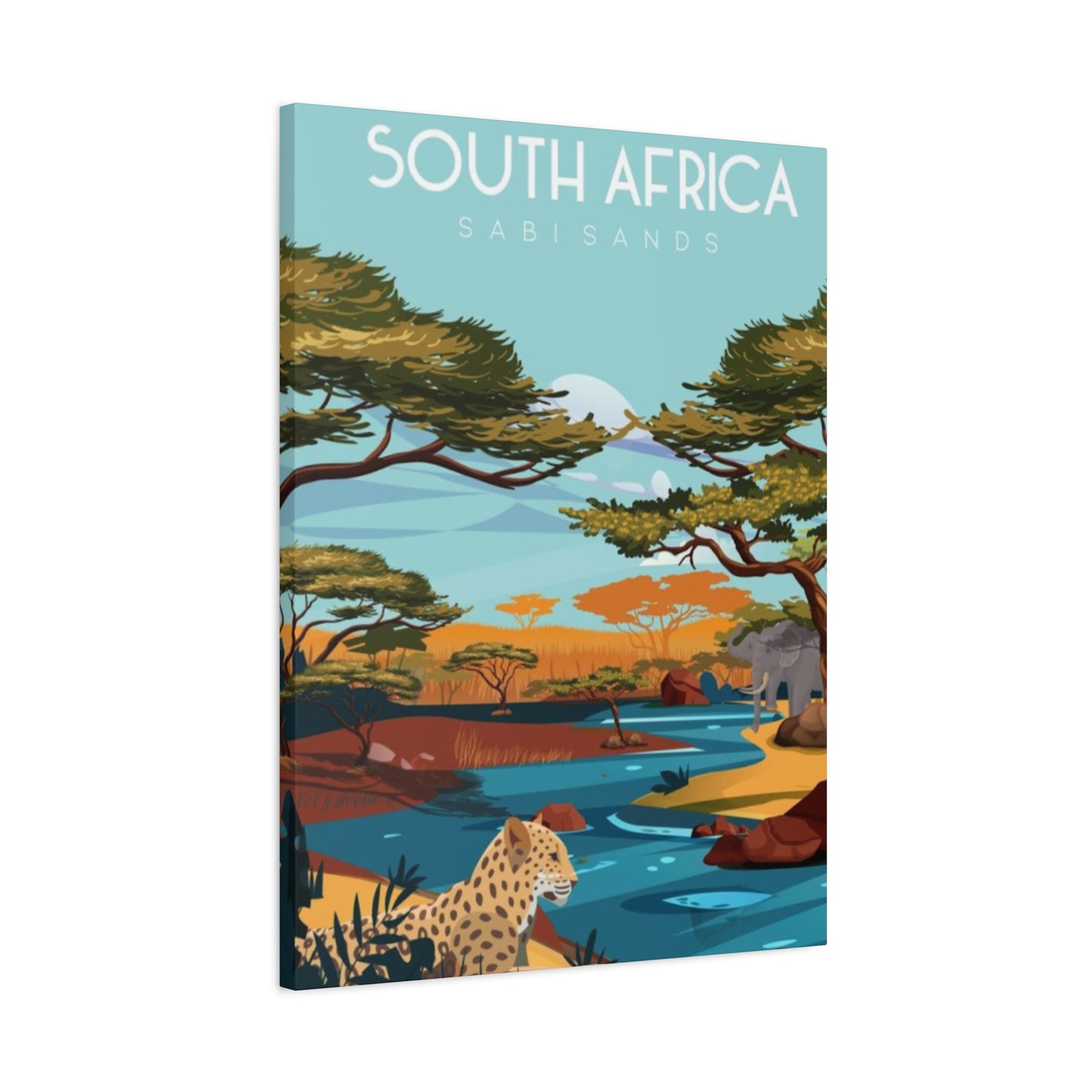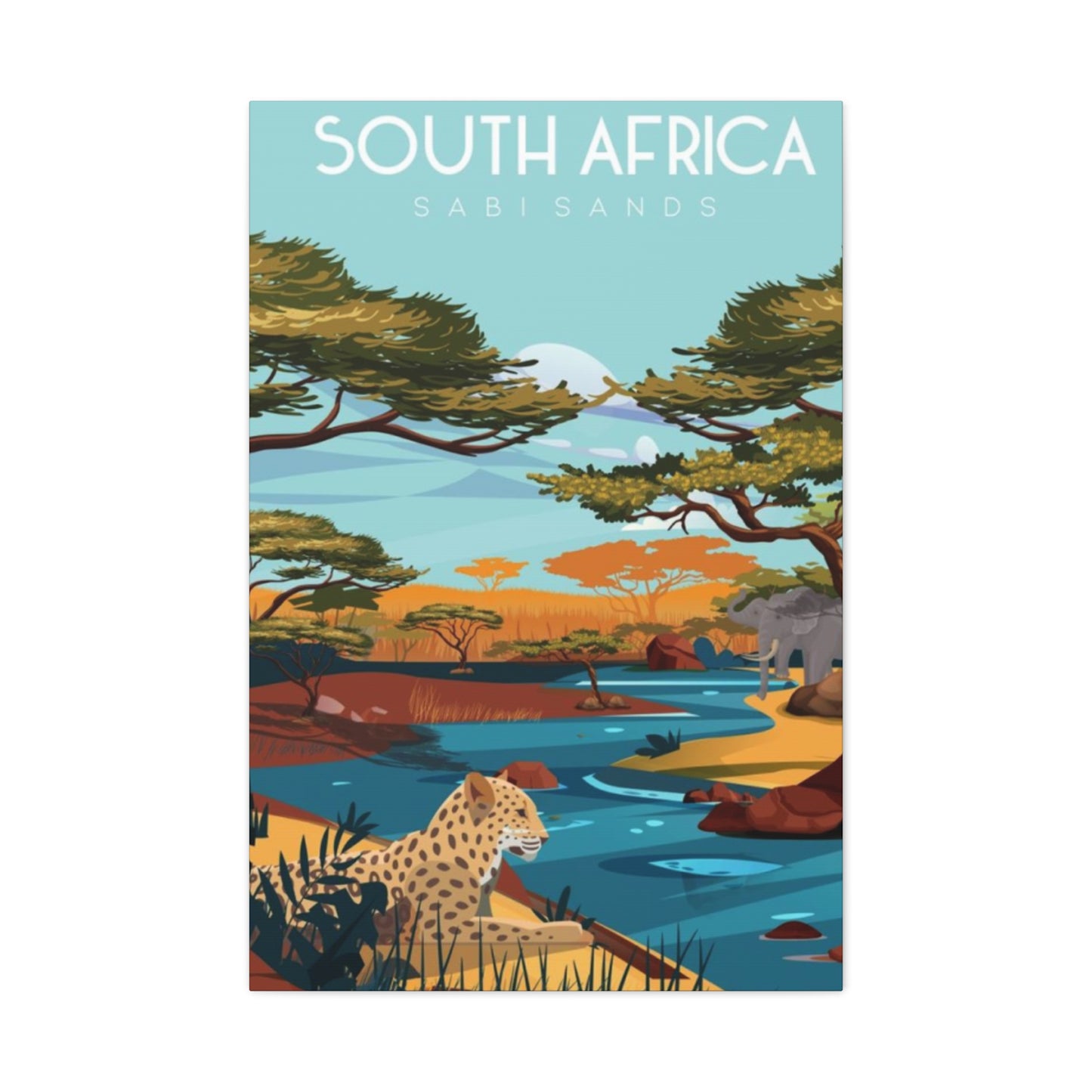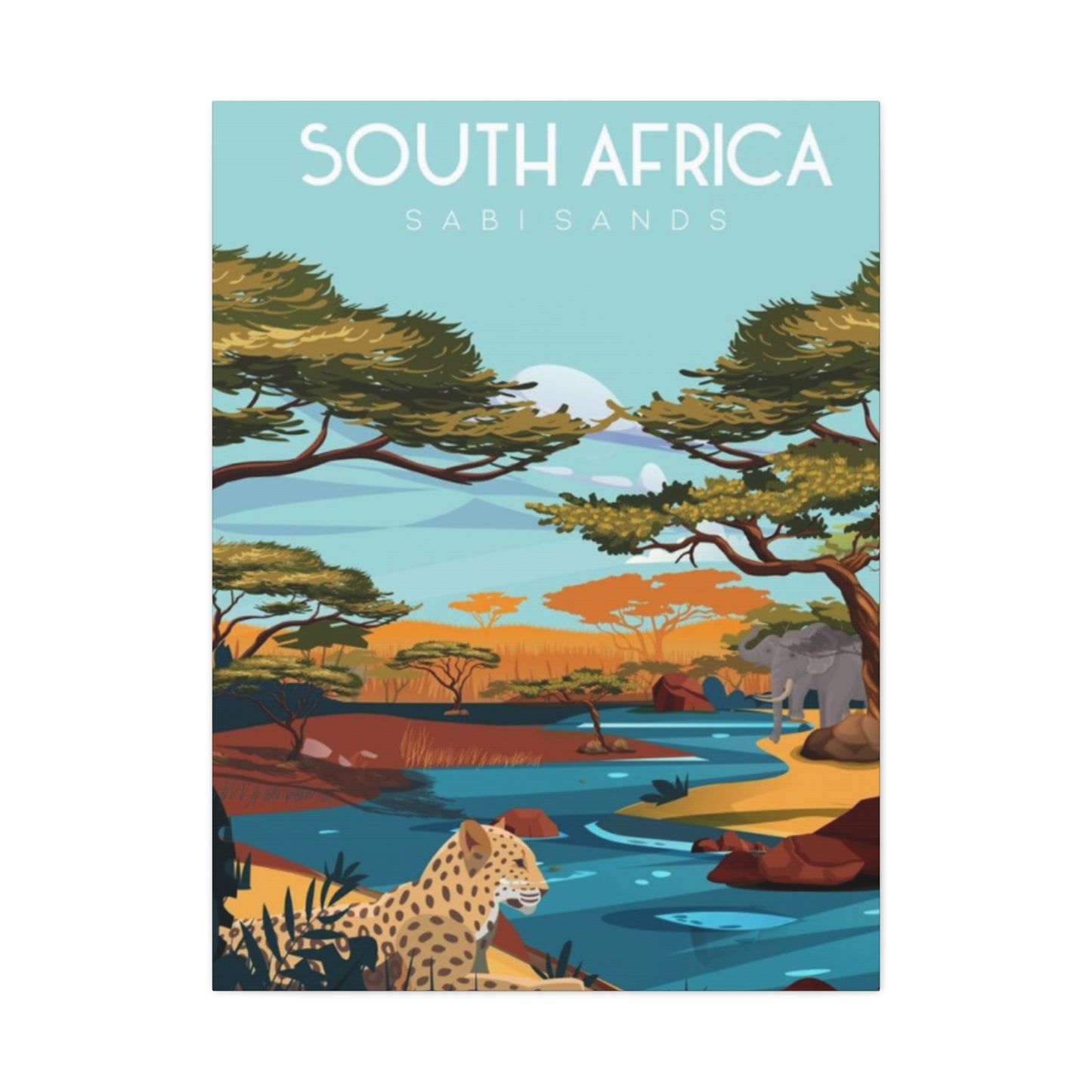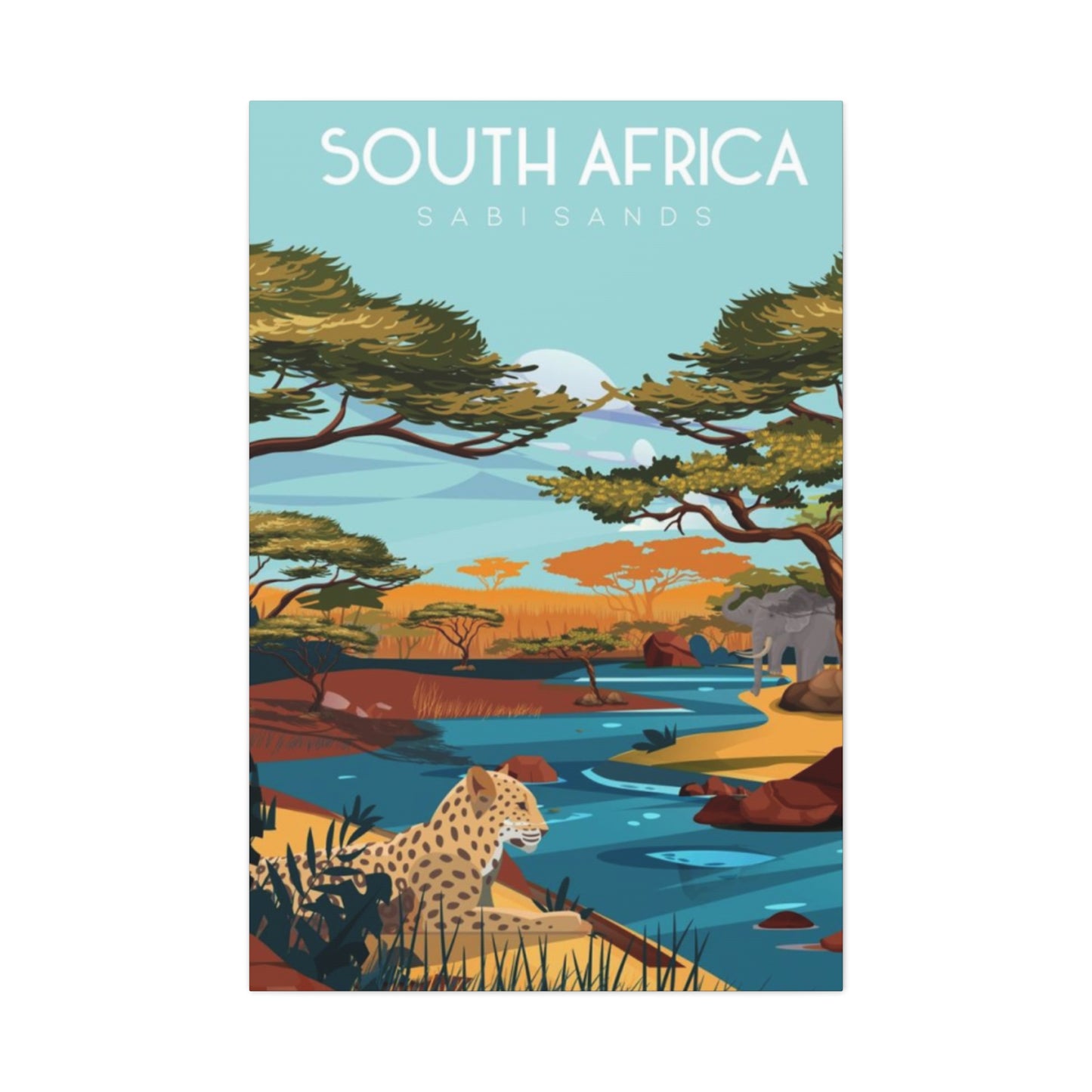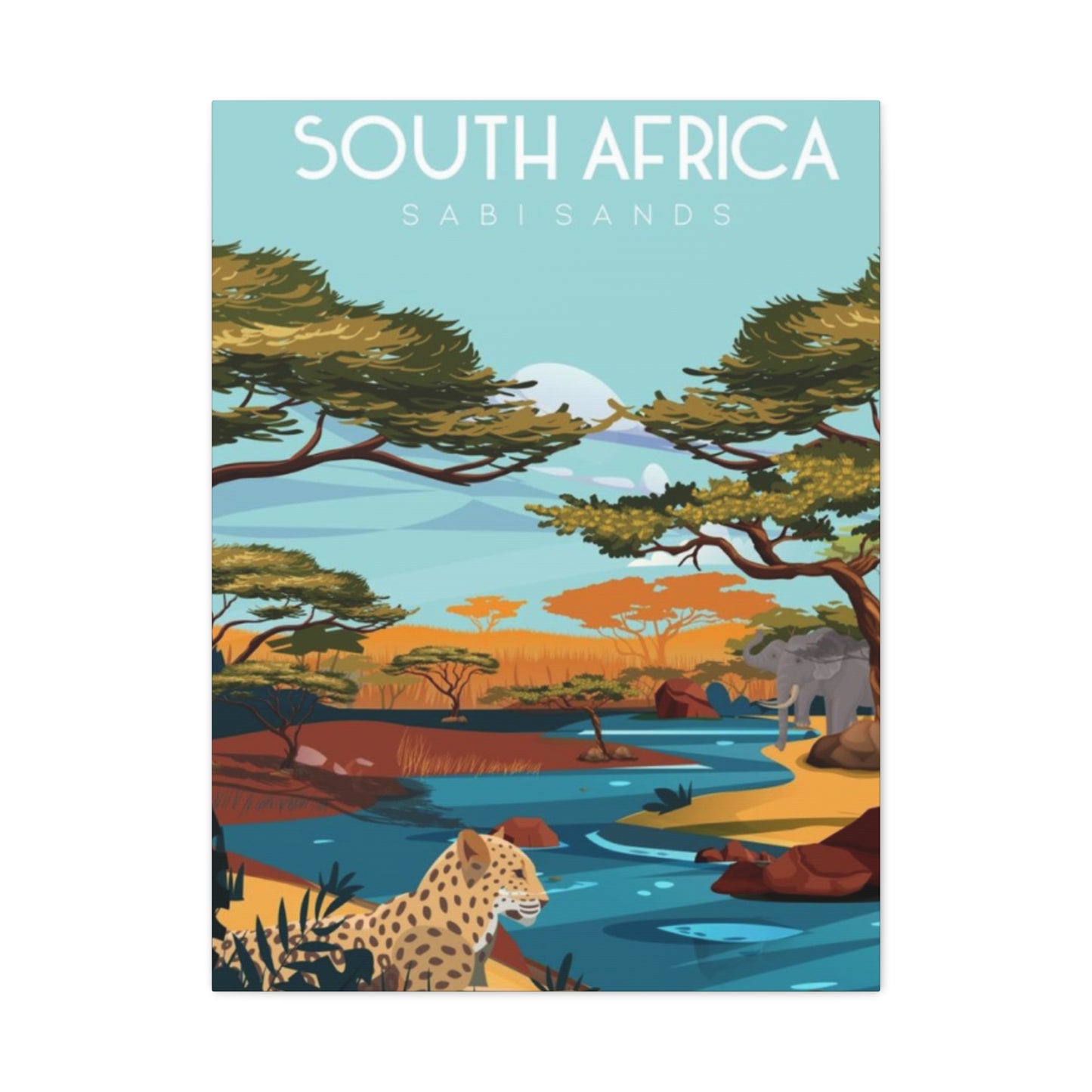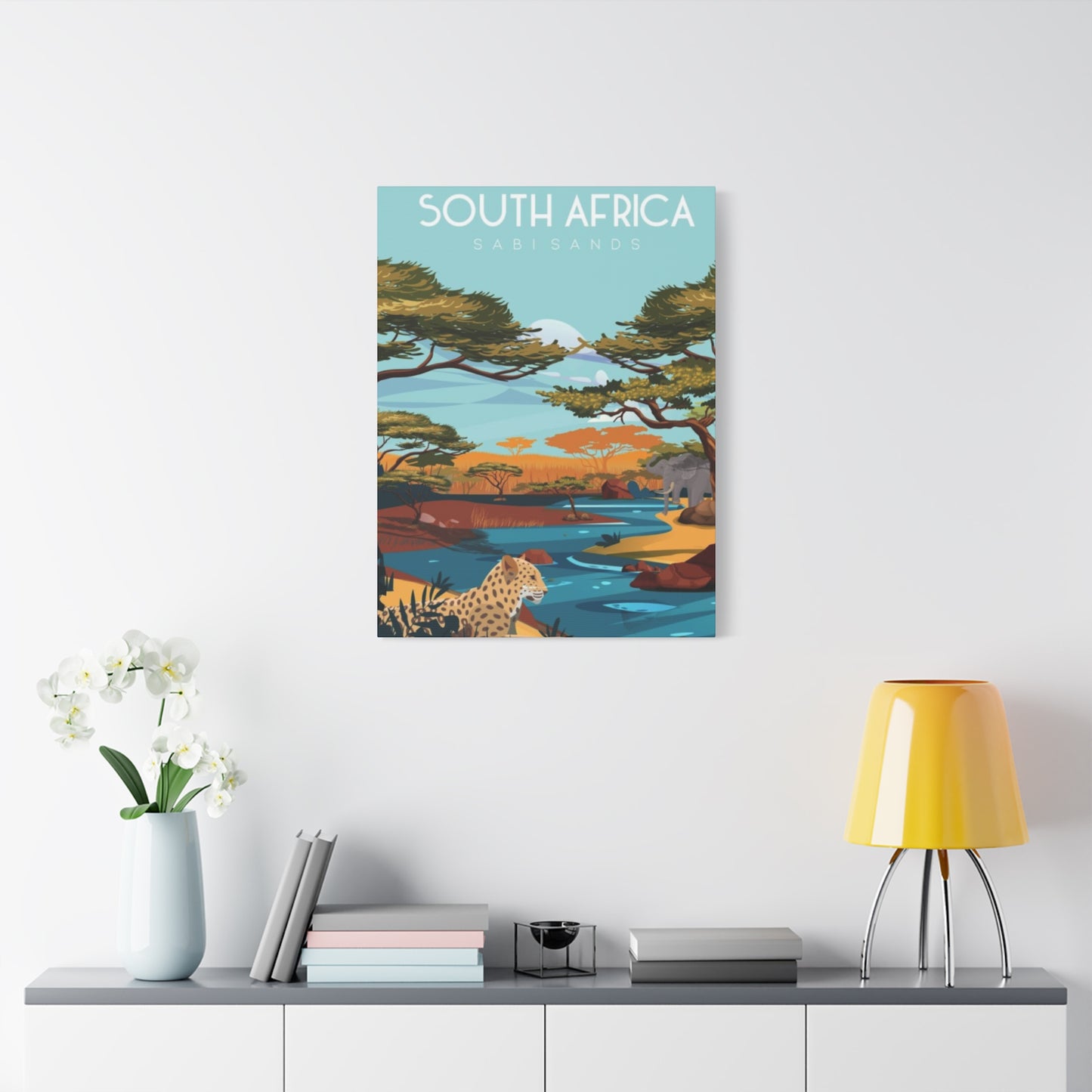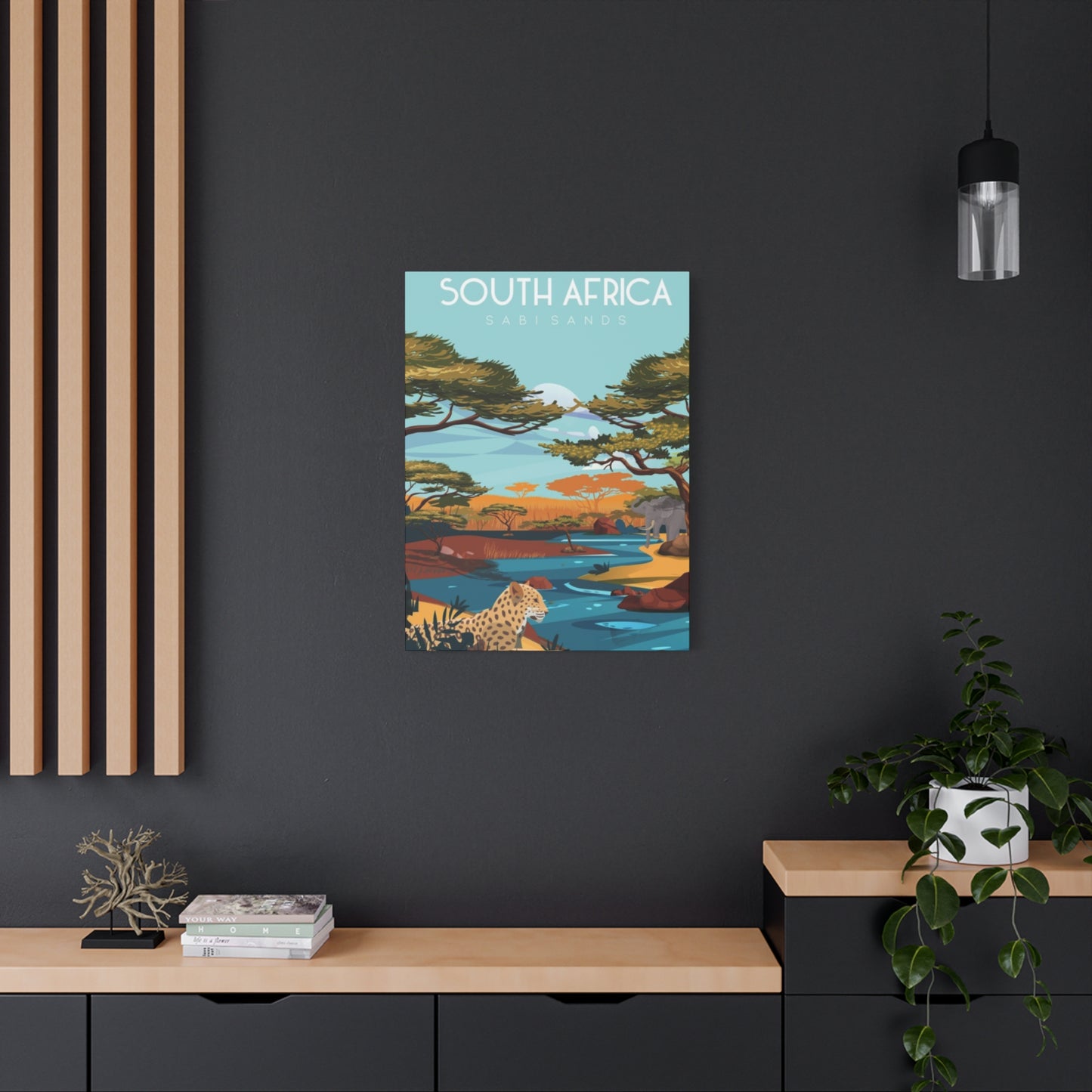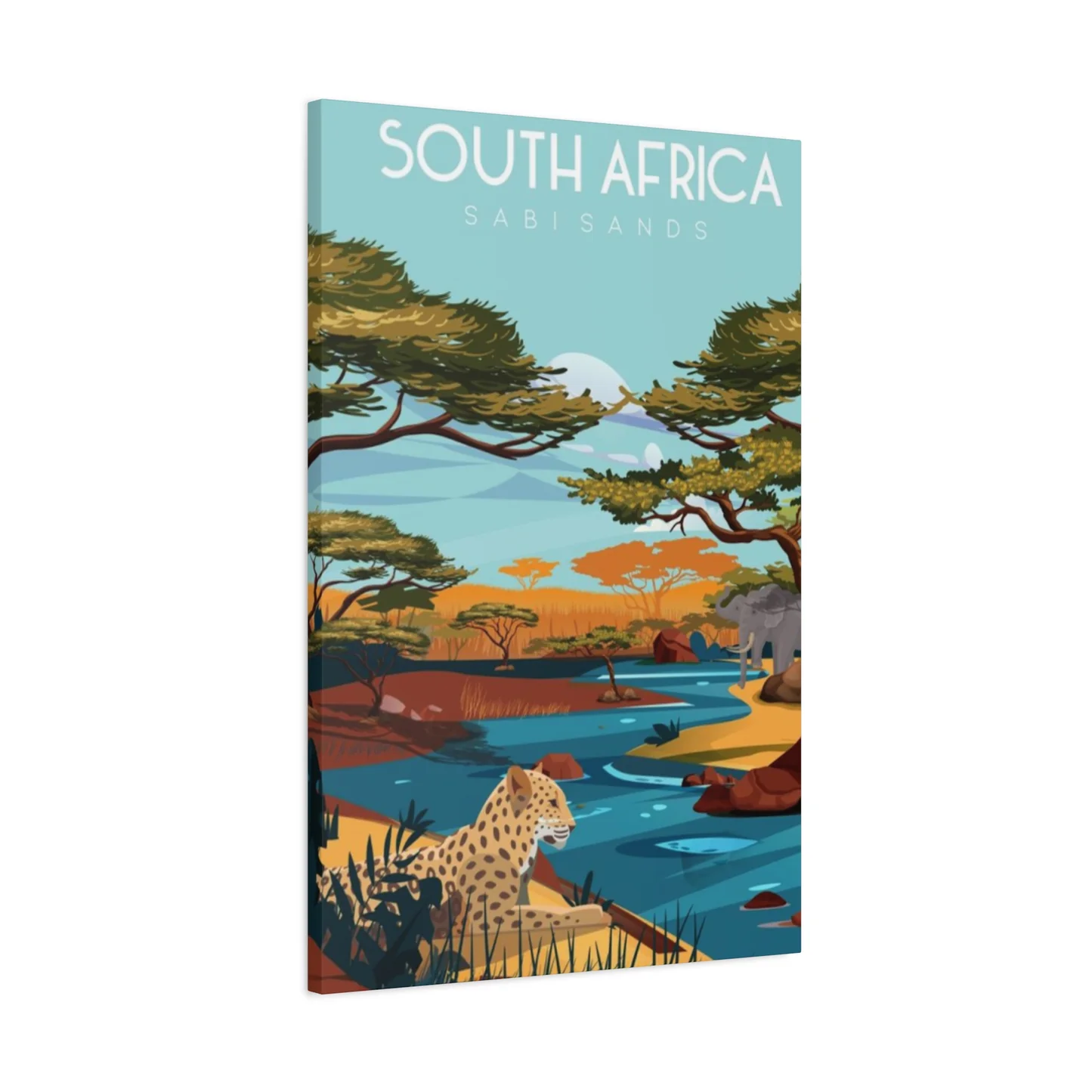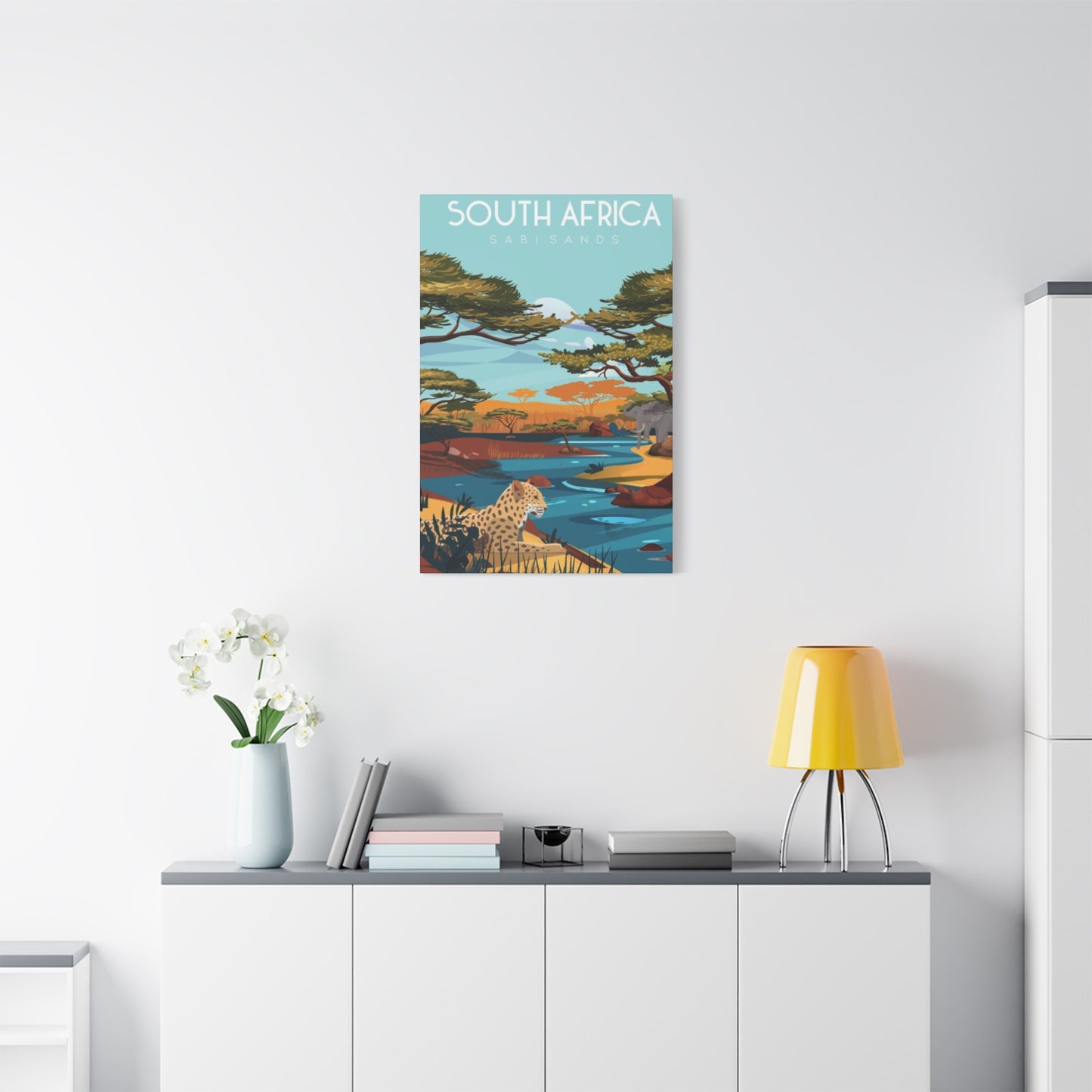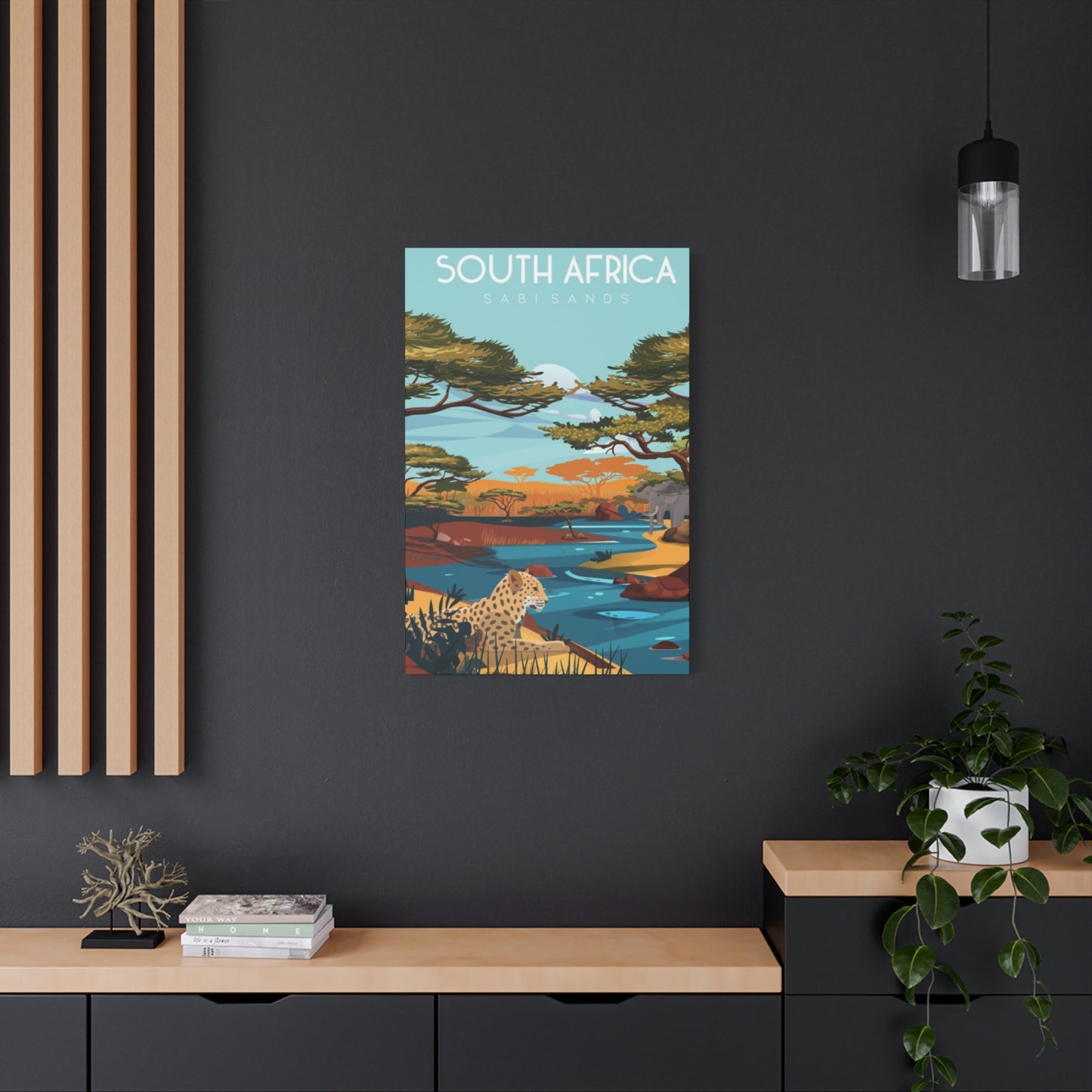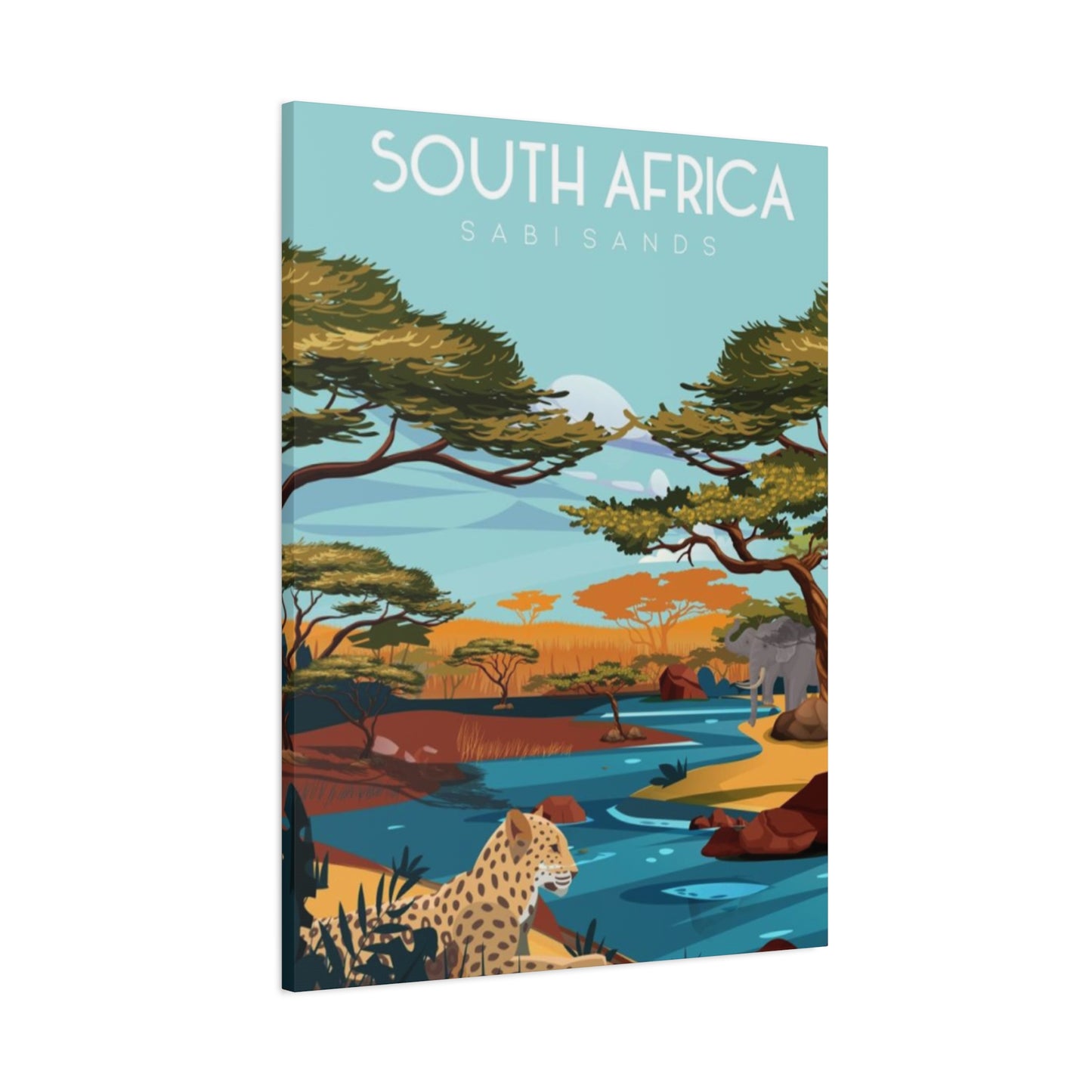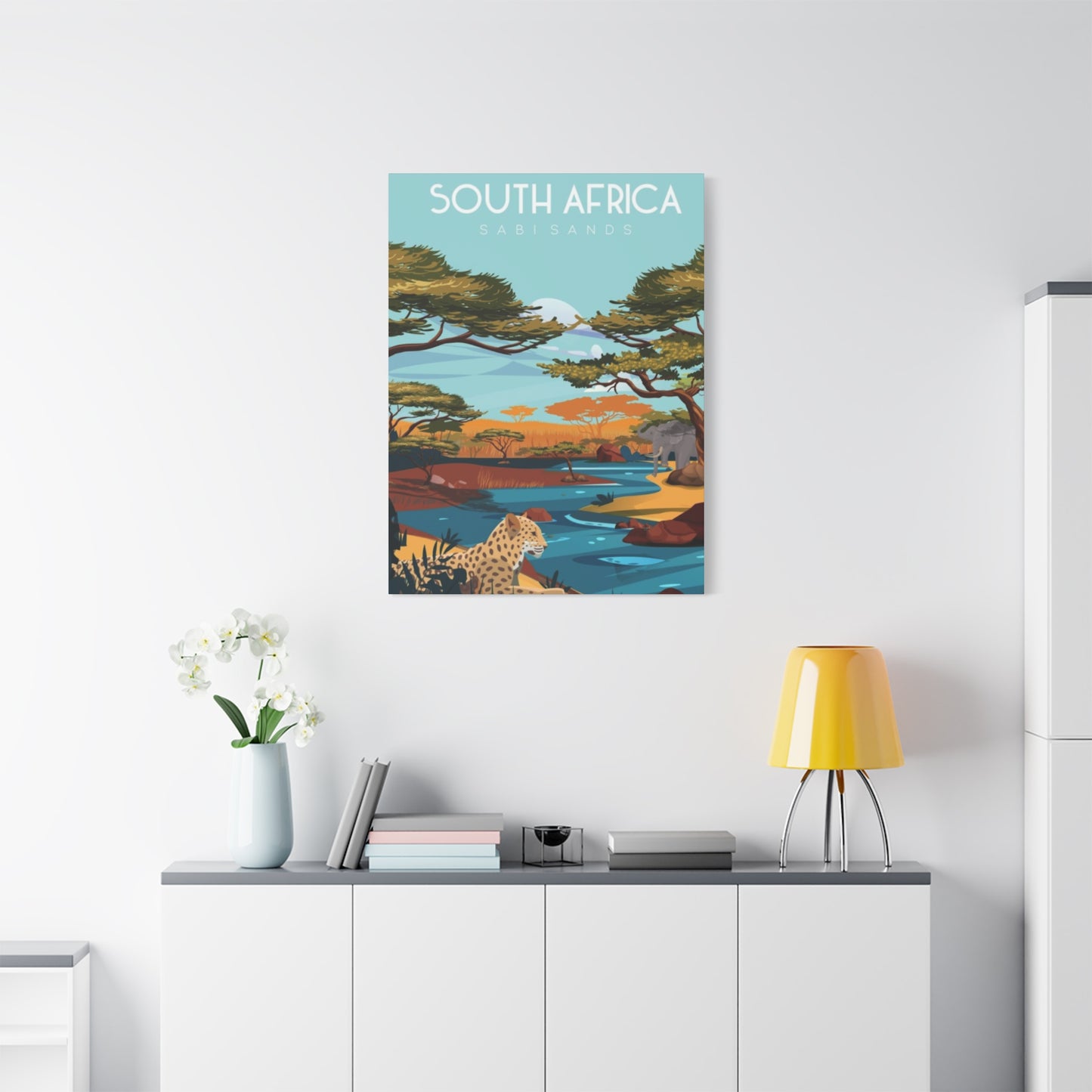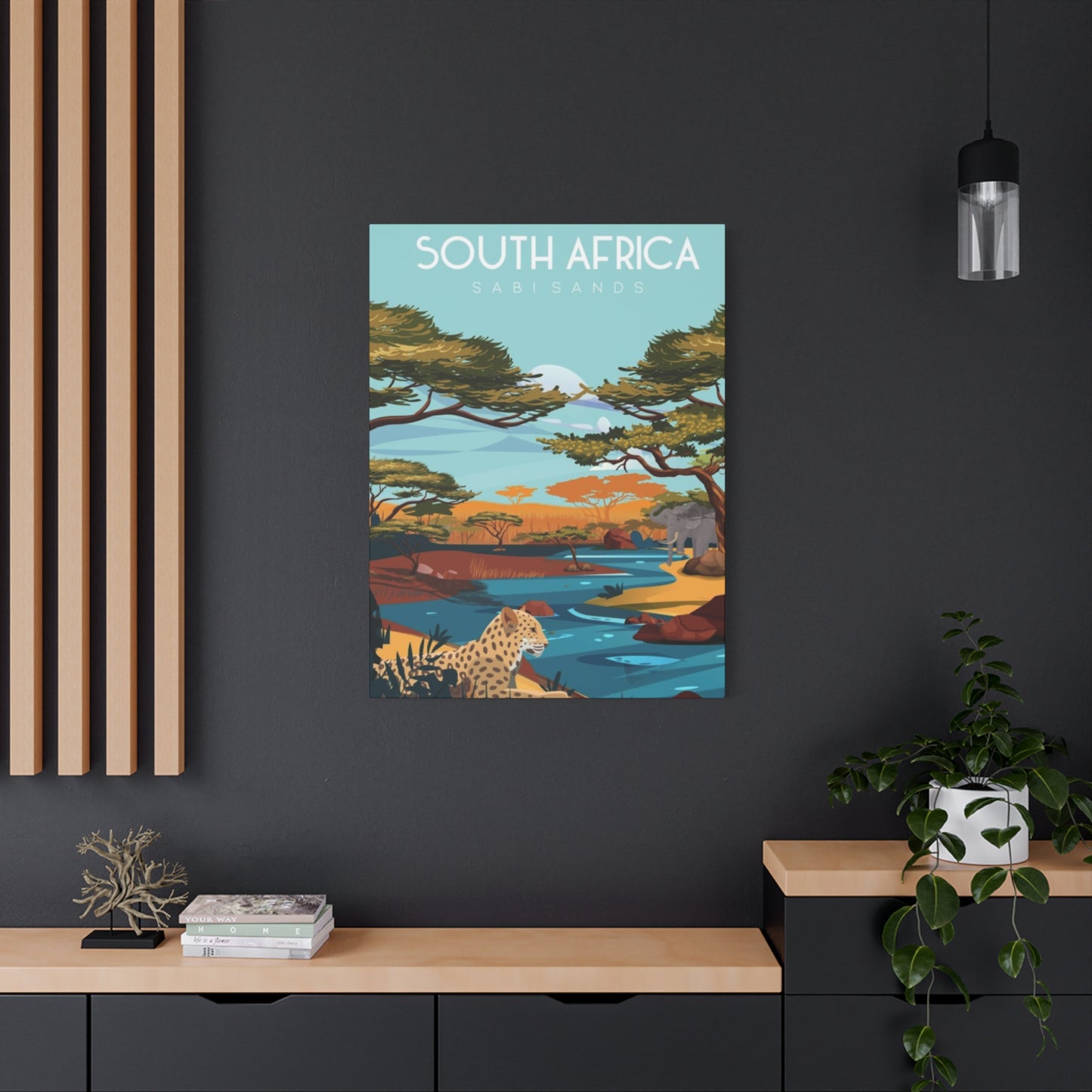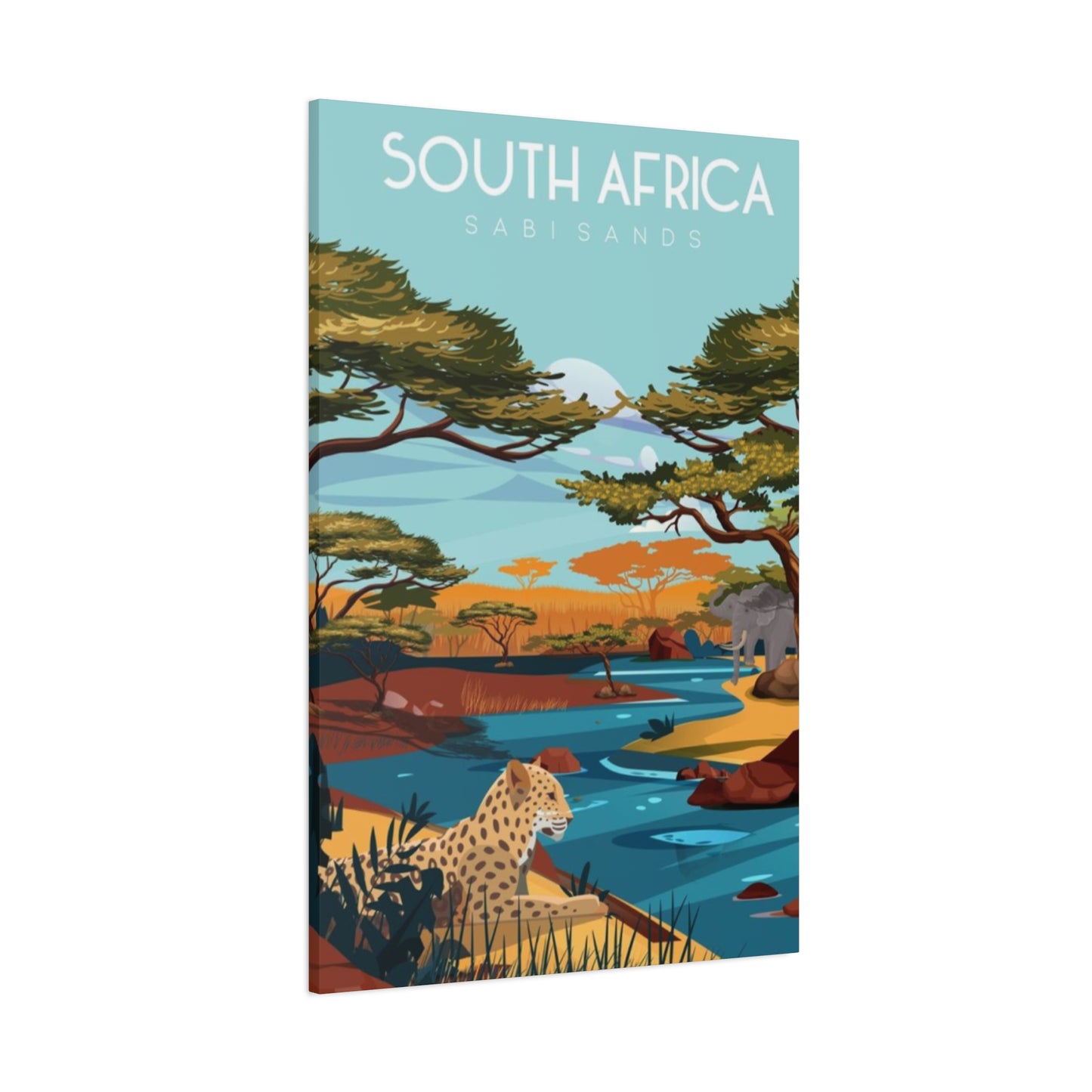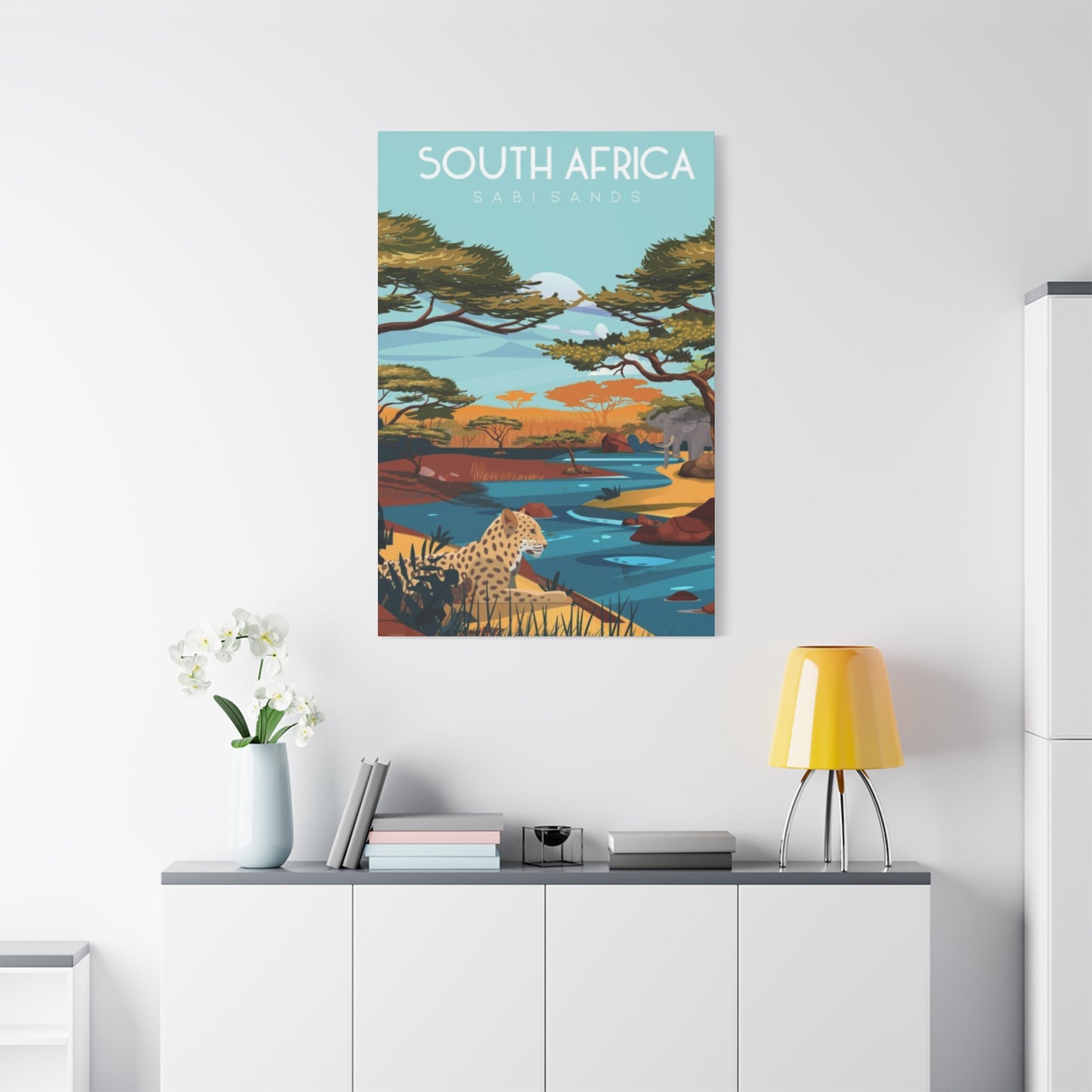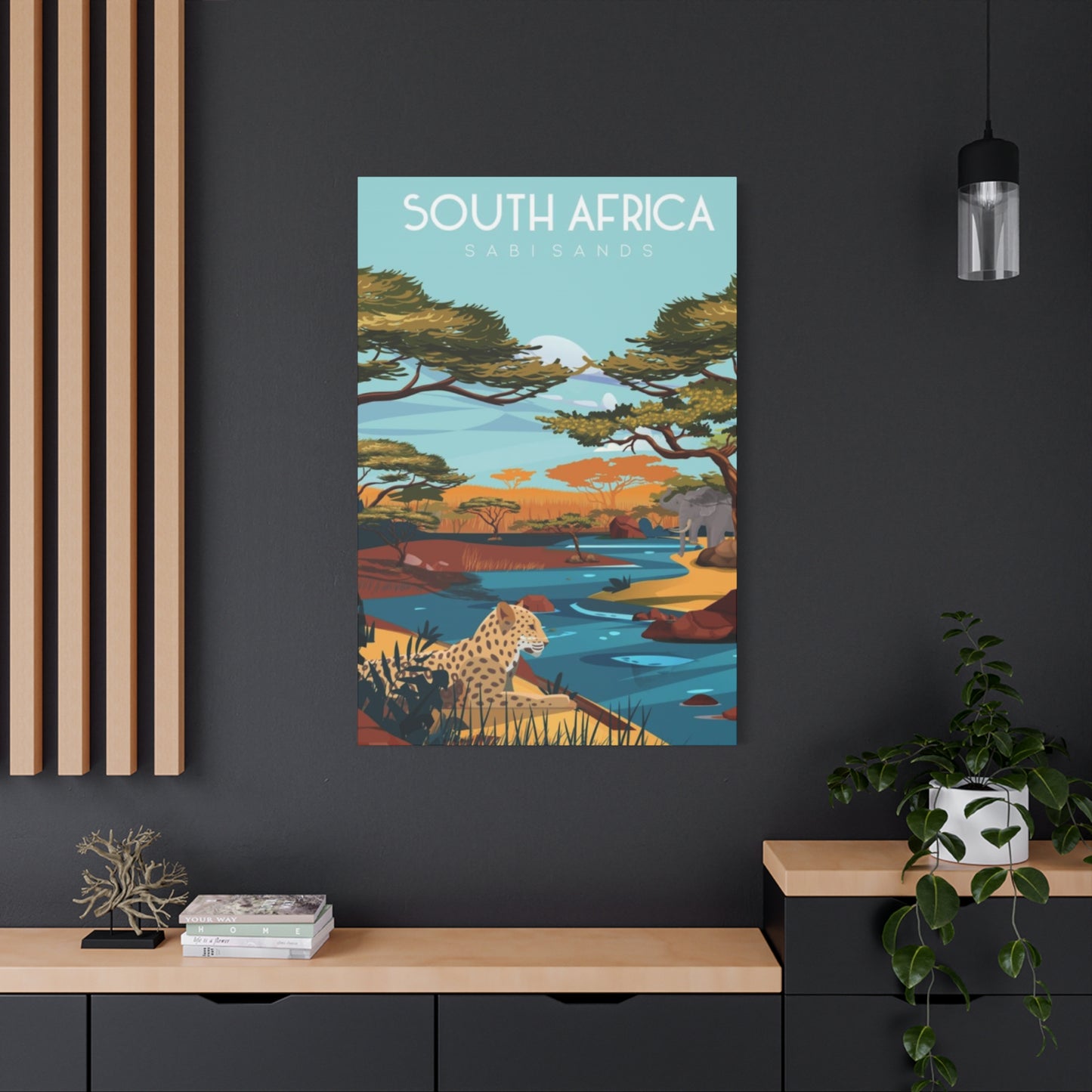Sabi Sands National Park Wall Art Canvas Prints - Premium African Wildlife Collection
The breathtaking landscapes and extraordinary wildlife of Sabi Sands Game Reserve offer an unparalleled opportunity to bring the essence of African wilderness into your home through carefully curated canvas prints. This private game reserve, adjacent to Kruger National Park in South Africa, represents one of the continent's most pristine wildlife sanctuaries, where photographers and artists have captured moments of raw beauty that translate perfectly into stunning visual artwork.
Canvas prints featuring the diverse ecosystem of this remarkable reserve showcase everything from the iconic Big Five animals to the subtle beauty of lesser-known species that call this area home. The artistic representation of these magnificent creatures serves not only as decorative elements but as powerful reminders of the natural world's incredible diversity and the importance of conservation efforts in protecting these precious habitats.
The photographic artistry captured within this reserve tells stories of survival, adaptation, and the delicate balance that exists within African ecosystems. Each canvas print represents hours of patient observation, technical expertise, and deep respect for wildlife, resulting in images that convey both the power and vulnerability of these remarkable animals in their natural environment.
Professional wildlife photographers who have spent countless hours documenting life within Sabi Sands have created a treasure trove of visual material that translates beautifully onto canvas. The high-quality printing techniques used to reproduce these images ensure that every detail, from the texture of an elephant's skin to the piercing gaze of a leopard, is preserved with stunning clarity and color accuracy.
The emotional connection that viewers develop with these artistic representations often inspires a deeper appreciation for wildlife conservation. When you display these powerful images in your home, you become part of a larger narrative about protecting these magnificent creatures and their habitats for future generations to experience and cherish.
African Safari Photography Transformed into Timeless Artwork
The transformation of safari photography into canvas artwork represents a fascinating intersection between wildlife documentation and artistic expression. Professional photographers who venture into Sabi Sands Game Reserve face unique challenges and opportunities that result in images of exceptional quality and emotional depth, perfect for artistic reproduction.
The golden hours of African sunrises and sunsets provide photographers with natural lighting conditions that create dramatic shadows, warm color palettes, and atmospheric effects that translate beautifully onto canvas prints. These optimal lighting conditions, combined with the incredible biodiversity of the reserve, result in photographs that capture not just the physical appearance of animals but their behavioral patterns, social interactions, and individual personalities.
Canvas printing technology has evolved significantly, allowing for the reproduction of wildlife photography with unprecedented detail and color fidelity. The texture of canvas adds depth and dimension to these images, creating a tactile quality that enhances the viewing experience and makes each print feel more like an original work of art than a simple reproduction.
The artistic merit of safari photography lies not only in technical proficiency but in the photographer's ability to anticipate and capture fleeting moments of natural behavior. Whether it's a lioness teaching her cubs to hunt, elephants gathering at a watering hole during drought conditions, or a leopard's stealthy approach through tall grass, these moments become frozen in time through the lens and later transformed into lasting artistic statements.
The process of selecting which images work best as canvas prints involves careful consideration of composition, color balance, and emotional impact. Images that tell compelling stories or showcase the raw beauty of African wildlife tend to create the most powerful visual impact when displayed as large-format canvas prints in residential or commercial settings.
Capturing the Essence of Big Five Animals in Artistic Form
The legendary Big Five animals of Africa - lions, elephants, rhinoceros, leopards, and Cape buffalo - represent some of the most sought-after subjects for wildlife photography and subsequent canvas artwork. Each of these magnificent creatures possesses unique characteristics that challenge photographers and inspire artists to capture their essence in different ways.
Lions, often referred to as the kings of the African savanna, provide photographers with opportunities to capture both their regal bearing and complex social dynamics. Male lions with their impressive manes create striking portraits that showcase power and nobility, while lionesses demonstrate grace, intelligence, and fierce protective instincts when caring for their young. The social structure of lion prides offers endless possibilities for capturing interaction, cooperation, and the subtle hierarchies that govern their daily lives.
African elephants, the largest land mammals on Earth, present unique challenges for photographers due to their massive size and often unpredictable behavior. However, these gentle giants also provide some of the most emotionally resonant images when captured in family groups, showing the deep bonds between mothers and calves or the wisdom reflected in the eyes of ancient matriarchs who have survived decades in the wild.
Rhinoceros photography requires patience and respect for these powerful yet vulnerable creatures. Both black and white rhinoceros species can be found in Sabi Sands, and capturing their prehistoric appearance and gentle nature despite their formidable horns creates compelling contrasts that translate beautifully into artistic representations.
Leopards represent perhaps the most challenging of the Big Five to photograph due to their solitary, nocturnal nature and incredible camouflage abilities. When successfully captured on camera, these elusive cats create some of the most striking canvas prints, with their spotted coats and piercing eyes conveying mystery, power, and wild beauty that captivates viewers.
Cape buffalo, often underestimated among the Big Five, possess a raw power and unpredictability that experienced photographers learn to respect. These massive bovines create impressive subjects when captured in herds moving across the landscape or when individual bulls are photographed showcasing their massive horns and intense expressions.
The Art of Wildlife Behavior Documentation Through Canvas Prints
Wildlife behavior documentation represents one of the most fascinating aspects of safari photography that translates exceptionally well into canvas artwork. The ability to capture animals engaged in natural behaviors provides viewers with intimate glimpses into the daily lives of African wildlife that would otherwise remain hidden from human observation.
Predator-prey interactions offer some of the most dramatic photographic opportunities, though they require photographers to maintain respectful distances while documenting these crucial ecological processes. The tension captured in images of hunting sequences, territorial disputes, or protective behaviors creates powerful emotional responses that make these canvas prints conversation starters and educational tools simultaneously.
Parental behaviors across different species provide heartwarming subjects for canvas artwork. Elephant mothers guiding their calves, lionesses grooming their cubs, or antelope teaching their young to recognize danger signals showcase the universal nature of parental care across the animal kingdom. These gentle moments contrast beautifully with more dramatic hunting or territorial behaviors, providing balance in wildlife art collections.
Seasonal behaviors such as migration patterns, mating rituals, and adaptation to changing environmental conditions offer photographers opportunities to document how wildlife responds to natural cycles. During the dry season, animals gathering around limited water sources create compelling compositions that highlight both the beauty and harsh realities of life in the African wilderness.
Communication behaviors between animals of the same species provide fascinating subjects for artistic documentation. Elephants touching trunks in greeting, lions engaging in social bonding through grooming, or the complex vocalizations and body language used by various species all translate into powerful visual narratives when captured by skilled photographers.
The feeding behaviors of different species, from browsers delicately selecting leaves to predators sharing kills, demonstrate the incredible diversity of ecological niches that exist within African ecosystems. These images help viewers understand the complex web of relationships that sustain wildlife populations in their natural habitats.
Landscape Photography and Environmental Storytelling
The magnificent landscapes of Sabi Sands Game Reserve provide the perfect backdrop for wildlife photography while also serving as compelling subjects for canvas artwork in their own right. The diverse habitats within the reserve, from dense riverine forests to open grasslands and rocky outcroppings, create varied environments that support different wildlife species while offering photographers rich compositional opportunities.
The Sabi and Sand Rivers that give the reserve its name provide crucial water sources that attract wildlife throughout the year, creating natural gathering points where photographers can document both the landscapes and the animals that depend on these water sources for survival. The interplay between water, vegetation, and wildlife creates dynamic compositions that tell stories about ecosystem interdependence.
Ancient trees, some hundreds of years old, serve as both wildlife habitat and striking photographic subjects. These venerable giants have witnessed generations of wildlife activity and provide nesting sites for birds, shade for grazing animals, and landmark navigation points for migrating species. Canvas prints featuring these majestic trees often evoke feelings of permanence and continuity that resonate deeply with viewers.
The dramatic African skies, with their towering thunderclouds, brilliant sunrises, and spectacular sunsets, provide photographers with ever-changing backdrops that enhance wildlife photography while creating stunning landscape images. The quality of light throughout the day transforms familiar scenes into completely different artistic compositions, allowing photographers to capture the same locations with entirely different moods and emotions.
Seasonal changes in vegetation, from the lush greens of the wet season to the golden browns of winter, provide natural variety in landscape photography. These seasonal transformations affect wildlife behavior and distribution, creating opportunities for photographers to document how animals adapt to changing environmental conditions throughout the year.
The geological features of the region, including granite outcroppings, ancient riverbeds, and natural rock formations, add texture and visual interest to landscape compositions while providing crucial habitat elements for various wildlife species. These geological features tell stories about the ancient history of the region while serving as important ecosystem components in the present day.
Technical Excellence in Wildlife Canvas Print Production
The production of high-quality wildlife canvas prints requires sophisticated printing technologies and materials that can accurately reproduce the subtle details and vibrant colors captured by professional wildlife photographers. Modern digital printing techniques have revolutionized the ability to create artwork that maintains the integrity of original photographs while adding the textural qualities that make canvas prints so appealing.
Color accuracy remains paramount in wildlife canvas print production, as the subtle variations in animal coats, the warm tones of African sunlight, and the rich colors of natural habitats must be reproduced with precision to maintain the emotional impact of original photographs. Advanced color management systems ensure that the colors viewers see in the final canvas prints match the photographer's original vision.
The choice of canvas material significantly impacts the final appearance and longevity of wildlife prints. High-quality cotton or polyester canvas provides the ideal surface for reproducing fine photographic details while offering the texture and depth that distinguish canvas prints from other reproduction methods. The weave of the canvas must be fine enough to maintain detail reproduction while providing the characteristic texture that enhances the artistic quality of the final product.
Ink quality and permanence are crucial factors in producing wildlife canvas prints that will maintain their visual impact for decades. Pigment-based inks offer superior fade resistance compared to dye-based alternatives, ensuring that these artistic representations of African wildlife will retain their colors and details for many years when properly displayed and cared for.
The stretching and mounting process requires expertise to ensure that canvas prints maintain proper tension without damaging the printed surface. Professional mounting techniques protect the artwork while presenting it in ways that enhance its visual impact and make it suitable for long-term display in various environmental conditions.
Quality control measures throughout the production process ensure that each canvas print meets high standards for color accuracy, detail reproduction, and overall presentation. This attention to quality is essential when creating artwork that represents the magnificent wildlife and landscapes of one of Africa's premier game reserves.
Conservation Awareness Through Artistic Expression
Wildlife canvas prints serve as powerful tools for raising awareness about conservation issues while bringing the beauty of African wildlife into homes and offices around the world. Each image tells a story not only about the individual animals depicted but also about the broader challenges facing wildlife populations and their habitats in the modern world.
The educational value of wildlife artwork extends beyond simple appreciation of natural beauty to encompass understanding of ecological relationships, behavioral patterns, and conservation challenges. When viewers connect emotionally with these artistic representations, they often develop a deeper interest in learning about the real animals and their conservation needs.
Many wildlife photographers who contribute images for canvas print production also participate in conservation research and documentation projects. Their work helps scientists and conservationists understand wildlife behavior, population dynamics, and habitat requirements while creating artistic records of species and ecosystems that may face future threats.
The economic impact of wildlife art purchases can contribute directly to conservation efforts when photographers and print producers donate portions of their proceeds to wildlife protection organizations. This creates a positive feedback loop where appreciation for wildlife art translates directly into financial support for conservation initiatives.
Educational programs that use wildlife canvas prints as teaching tools help people of all ages develop appreciation for biodiversity and understand the importance of protecting natural habitats. These artistic representations can spark conversations about environmental stewardship and inspire action to support conservation efforts both locally and internationally.
The documentation aspect of wildlife photography preserved in canvas prints creates valuable historical records of wildlife populations and behaviors that may change over time due to environmental pressures or conservation successes. Future researchers and conservationists may find these artistic records invaluable for understanding how wildlife populations and behaviors have evolved over time.
Seasonal Wildlife Photography and Artistic Representation
The seasonal variations in Sabi Sands Game Reserve provide wildlife photographers with dramatically different opportunities throughout the year, resulting in diverse artistic representations that showcase how African wildlife adapts to changing environmental conditions. Each season brings unique challenges and opportunities that influence both wildlife behavior and photographic possibilities.
The wet summer season, typically from November to March, transforms the landscape into a lush, green environment that supports abundant wildlife activity. During this period, many animals give birth to their young, taking advantage of plentiful food resources and favorable weather conditions. Photographers capture tender moments between mothers and offspring while documenting the vibrant colors and dramatic skies that characterize the rainy season.
The winter dry season, from May to September, concentrates wildlife around remaining water sources, creating exceptional opportunities for photographing multiple species in single compositions. The sparse vegetation during this period allows for better visibility of animal movements and behaviors, while the harsh environmental conditions often reveal the resilience and adaptability that allow wildlife species to survive in challenging circumstances.
Migration patterns during transitional seasons provide photographers with opportunities to document large-scale wildlife movements and the complex social behaviors that accompany these seasonal journeys. Canvas prints capturing these migration scenes often convey a sense of movement and purpose that resonates powerfully with viewers who may never witness such phenomena in person.
The changing quality of light throughout different seasons affects the mood and emotional impact of wildlife photography. The crisp, clear light of winter mornings creates sharp, detailed images with strong contrast, while the softer, more diffused light of the rainy season produces photographs with gentler tones and more subtle color variations.
Weather events such as thunderstorms, morning mists, and seasonal flooding create dramatic backdrops for wildlife photography. These atmospheric conditions add emotional depth to images and often result in some of the most memorable and impactful canvas prints that capture not just wildlife but the dynamic nature of African weather patterns.
The behavioral changes that accompany seasonal transitions provide photographers with opportunities to document adaptation strategies that have evolved over thousands of years. Canvas prints featuring these behavioral adaptations serve as both artistic expressions and scientific documentation of wildlife resilience and intelligence.
Nocturnal Wildlife Photography and Low-Light Artistic Techniques
The nocturnal activities of many African wildlife species present unique challenges and opportunities for photographers seeking to create compelling canvas artwork. The advanced technology available to modern wildlife photographers has made it possible to capture detailed images of nighttime behaviors that were previously impossible to document artistically.
Leopards, being primarily nocturnal hunters, provide some of the most dramatic subjects for low-light photography. Their spotted coats and piercing eyes create striking contrasts in nighttime images, while their stealthy hunting behaviors offer photographers opportunities to capture the essence of wild predation in atmospheric conditions.
The use of specialized lighting techniques and high-sensitivity camera equipment allows photographers to capture nocturnal scenes without disturbing natural wildlife behaviors. These technical advances have opened up entirely new possibilities for wildlife art that showcases the mysterious and often unseen aspects of African wildlife activity.
Dawn and dusk periods, when many nocturnal and diurnal species are simultaneously active, provide photographers with unique opportunities to capture transitional moments in wildlife daily cycles. The soft, warm light during these periods creates ideal conditions for producing canvas prints with exceptional emotional depth and visual appeal.
Night photography often reveals different aspects of familiar wildlife species, showing how their behaviors change when they believe they are unobserved by humans. These intimate glimpses into nighttime activities provide viewers with deeper understanding of wildlife complexity while creating artwork that feels exclusive and special.
The challenges of nocturnal photography, including limited lighting conditions and unpredictable animal movements, require exceptional skill and patience from photographers. When successful, these efforts result in unique artistic representations that stand out from the more common daylight wildlife photography typically seen in canvas print collections.
The atmospheric qualities of African nights, including star-filled skies, moonlight filtering through trees, and the sounds of nocturnal activity, all contribute to creating images that convey the magic and mystery of wilderness experiences that few people ever witness personally.
Bird Photography and Avian Artistic Representation
The incredible diversity of bird species found in Sabi Sands Game Reserve provides wildlife photographers with endless opportunities to create stunning canvas artwork featuring avian subjects. From massive ground-dwelling species like ostriches to tiny, brilliantly colored sunbirds, the variety of sizes, colors, and behaviors among bird species creates rich possibilities for artistic expression.
Raptors, including various eagle, hawk, and owl species, provide photographers with opportunities to capture power, grace, and hunting prowess in single images. The intense focus visible in raptor eyes, combined with their impressive wingspans and aerodynamic forms, creates artwork that conveys both beauty and raw power.
Water birds associated with the rivers and wetlands within the reserve offer photographers colorful subjects with interesting feeding behaviors and social interactions. Species such as kingfishers, herons, and various duck species create opportunities for capturing both individual portraits and complex behavioral documentation.
The seasonal migrations that bring various bird species through the reserve provide photographers with opportunities to document species that may only be present for brief periods each year. These temporal limitations add exclusivity to canvas prints featuring migratory species while highlighting the importance of habitat conservation for species that depend on multiple locations throughout their annual cycles.
Flight photography presents unique technical challenges that result in dynamic, action-packed images when successfully executed. Canvas prints featuring birds in flight convey movement and freedom while showcasing the incredible adaptations that allow avian species to master aerial environments.
Nesting behaviors provide photographers with opportunities to document the complete life cycles of various bird species, from nest construction through egg incubation to chick rearing and fledging. These comprehensive behavioral documentation projects result in educational and emotionally engaging artwork that tells complete stories about avian family life.
The intricate patterns and brilliant colors found in many African bird species translate beautifully to canvas prints, with the texture of canvas enhancing the visual impact of detailed feather patterns and vibrant plumage colors that might be lost in other reproduction methods.
Mammalian Diversity and Artistic Documentation
Beyond the famous Big Five animals, Sabi Sands Game Reserve hosts an incredible diversity of mammalian species that provide photographers with opportunities to create comprehensive artistic documentation of African wildlife. From tiny mammals like bat-eared foxes to massive hippopotamuses, this diversity creates rich possibilities for varied and engaging canvas print collections.
Antelope species, including impala, kudu, waterbuck, and numerous others, provide photographers with subjects that showcase grace, alertness, and adaptation to specific ecological niches. The variety of horn shapes, coat patterns, and behavioral characteristics among different antelope species creates opportunities for both individual portraits and comparative studies that highlight evolutionary adaptation.
Primates such as vervet monkeys and chacma baboons offer photographers opportunities to capture complex social behaviors and individual personalities that resonate strongly with human viewers. The expressive faces and intricate social interactions of these species result in canvas prints that often evoke strong emotional responses and connection with wildlife.
Carnivores beyond the Big Five, including wild dogs, hyenas, and various smaller predators, provide photographers with subjects that showcase different hunting strategies and ecological roles. These often-overlooked species play crucial roles in ecosystem balance while offering unique opportunities for artistic representation that differs significantly from more commonly featured wildlife species.
Herbivorous megafauna such as giraffes and hippopotamuses present photographers with challenges related to their massive size while offering opportunities to showcase incredible anatomical adaptations. The elegant proportions of giraffes and the impressive bulk of hippos create striking subjects that demonstrate the incredible diversity of evolutionary solutions to survival challenges.
Nocturnal mammals that are rarely seen by casual safari visitors provide photographers with opportunities to create exclusive and mysterious artwork. Species such as aardvarks, pangolins, and various small carnivores offer subjects that feel exotic and special to viewers who may never have seen these animals in other contexts.
The behavioral diversity among mammalian species, from solitary hunters to complex social groups, provides photographers with opportunities to document and artistically represent the full spectrum of survival strategies that have evolved among African wildlife species.
Reptilian and Amphibian Photography in African Ecosystems
The reptilian and amphibian species found in Sabi Sands Game Reserve represent an often-overlooked component of African biodiversity that provides unique opportunities for specialized wildlife photography and artistic representation. These cold-blooded vertebrates play crucial ecological roles while offering photographers subjects with distinctive visual characteristics that translate well to canvas artwork.
Crocodiles, as apex aquatic predators, provide photographers with opportunities to capture both their fearsome predatory capabilities and their surprising maternal behaviors. The prehistoric appearance of these ancient reptiles creates artwork that evokes the primordial nature of African wilderness while highlighting the importance of aquatic habitats within terrestrial ecosystems.
Various snake species, from massive pythons to venomous vipers, offer photographers challenging subjects that require specialized techniques and extensive knowledge of reptilian behavior. The patterns, colors, and forms found among snake species create visually striking artwork while educating viewers about often-misunderstood animals that play important ecological roles.
Lizard species ranging from tiny geckos to large monitor lizards provide photographers with subjects that showcase incredible diversity in size, coloration, and behavioral adaptations. The detailed scales, brilliant colors, and unique defensive behaviors of various lizard species create opportunities for both macro photography and behavioral documentation.
Turtle and tortoise species found in and around aquatic habitats offer photographers subjects that represent longevity, patience, and adaptation to both aquatic and terrestrial environments. These ancient lineages create artwork that conveys a sense of permanence and continuity that contrasts with the more dynamic behaviors of other wildlife species.
Amphibian species, though often small and secretive, provide photographers with opportunities to document creatures that serve as important indicators of ecosystem health. The brilliant colors and unique life cycle adaptations of frogs and other amphibians create specialized artwork that appeals to viewers interested in the complete spectrum of biodiversity.
The seasonal activity patterns of reptiles and amphibians, which are closely tied to temperature and moisture conditions, provide photographers with opportunities to document how these species adapt to environmental variations throughout the year.
Insect and Arthropod Macro Photography for Artistic Expression
The incredible diversity of insects and other arthropods found in Sabi Sands Game Reserve provides photographers with opportunities to explore the miniature world that supports larger ecosystem functions. Macro photography techniques allow for the creation of canvas artwork that reveals the intricate beauty and complexity of creatures that are often overlooked by casual observers.
Butterfly and moth species offer photographers subjects with incredible wing patterns, brilliant colors, and delicate forms that create stunning artistic representations. The life cycle transformations of these insects, from caterpillars through chrysalis to adult forms, provide opportunities for documenting complete metamorphosis processes that fascinate viewers of all ages.
Bee species and other pollinators play crucial ecological roles that can be artistically documented through macro photography. Images showing the relationship between pollinators and flowering plants create educational artwork that highlights the interconnected nature of ecosystem functions while showcasing the beauty of these often-underappreciated creatures.
Predatory insects such as praying mantises, dragonflies, and various hunting spiders provide photographers with opportunities to capture miniature predator-prey relationships that mirror the larger-scale hunting behaviors more commonly associated with mammalian carnivores. These images reveal the complexity and efficiency of invertebrate predation strategies.
The architectural achievements of social insects, including termite mounds, ant colonies, and wasp nests, provide photographers with subjects that showcase incredible engineering capabilities and social organization. These structures represent some of the most impressive construction projects in the natural world while serving as crucial habitat components for other species.
Defensive adaptations among insects and arthropods, including camouflage, warning coloration, and behavioral displays, provide photographers with opportunities to document evolutionary solutions to survival challenges. These adaptations often result in visually striking subjects that create compelling canvas artwork while educating viewers about natural selection processes.
The seasonal emergence patterns of various insect species provide photographers with opportunities to document periodic phenomena that may only occur for brief periods each year, creating exclusive artwork that captures temporary but spectacular natural events.
Artistic Composition Techniques in Wildlife Photography
The creation of compelling wildlife canvas prints requires mastery of photographic composition techniques that enhance the natural beauty of animal subjects while creating visually engaging artwork that draws viewers into the image. Understanding and applying these compositional principles distinguishes professional-quality wildlife art from simple documentation photography.
The rule of thirds, while fundamental to all photography, takes on special significance in wildlife photography where the placement of animal subjects within the frame can dramatically affect the emotional impact of the final image. Positioning key elements along these imaginary lines creates dynamic compositions that feel natural and engaging to viewers while avoiding the static quality of centered subjects.
Leading lines, whether created by natural landscape features, animal movement patterns, or environmental elements, guide viewers' eyes through canvas prints while creating depth and visual flow. Rivers, fallen logs, game trails, and even the directional patterns of animal gazing create powerful compositional tools that enhance the storytelling aspect of wildlife artwork.
Framing techniques using natural elements such as vegetation, rock formations, or architectural features created by termites or other animals add depth and context to wildlife images while creating more complex visual experiences. These natural frames help isolate subjects from busy backgrounds while adding layers of visual interest that reward extended viewing.
The use of negative space, or areas without prominent visual elements, allows animal subjects to command attention while creating breathing room that prevents images from feeling cluttered or overwhelming. Skilled photographers understand how to balance detailed subjects with simplified backgrounds to create maximum visual impact.
Depth of field control enables photographers to selectively focus attention on specific elements within complex natural scenes. Shallow depth of field isolates subjects from backgrounds while creating pleasing blur effects, whereas deeper focus allows for environmental context that tells more complete stories about wildlife habitat relationships.
Color relationships and contrast management help create images that reproduce effectively as canvas prints while maintaining visual impact across different lighting conditions and viewing distances. Understanding how colors interact and complement each other enables photographers to create artwork that feels harmonious and professionally executed.
Environmental Context and Habitat Documentation
The artistic representation of wildlife through canvas prints becomes more meaningful and educational when it includes careful attention to environmental context and habitat documentation. The ecosystems of Sabi Sands Game Reserve provide rich backdrops that enhance wildlife imagery while educating viewers about the complex relationships between animals and their environments.
Riverine forests along the Sabi and Sand Rivers create lush, dense habitats that support different wildlife communities than the more open grassland areas. Photographers working in these environments capture the interplay between light and shadow that filters through canopy layers while documenting species that depend on this specialized habitat type.
Open grassland areas provide photographers with opportunities to capture wide-angle compositions that show wildlife in the context of vast African landscapes. These expansive views help viewers understand the scale of wilderness areas while showcasing how different species utilize open habitats for feeding, migration, and social behaviors.
Rocky outcroppings and kopjes serve as important habitat features that provide shelter, territorial advantages, and hunting opportunities for various wildlife species. The geological diversity of these features adds visual texture to compositions while demonstrating how landscape features influence animal distribution and behavior patterns.
Watering holes and seasonal pools concentrate wildlife activity during dry periods, creating opportunities for photographers to document interspecific interactions and competition for limited resources. These concentrated activity areas often result in dynamic compositions that tell stories about survival and adaptation in challenging environments.
Termite mounds and other biological architectural features create important habitat elements that support various wildlife species while adding unique visual elements to photographic compositions. These structures demonstrate the interconnected nature of African ecosystems while providing interesting foreground and background elements for wildlife photography.
Vegetation changes throughout different seasons affect both wildlife behavior and photographic opportunities, providing photographers with chances to document how animals adapt to changing food availability and environmental conditions throughout annual cycles.
Cultural and Historical Context of Wildlife Art
The tradition of depicting African wildlife through artistic expression extends far beyond modern photography and canvas printing technology, connecting contemporary wildlife art to ancient cultural practices and evolving relationships between humans and wildlife. Understanding this broader context enhances appreciation for modern wildlife canvas prints while placing them within larger cultural narratives.
Indigenous San peoples, who inhabited the region for thousands of years before European colonization, created rock art featuring wildlife species that continue to inhabit Sabi Sands Game Reserve today. These ancient artistic representations demonstrate the long-standing human fascination with wildlife while providing historical documentation of species distributions and cultural relationships with animals.
Early European explorers and naturalists created detailed sketches and paintings of African wildlife encounters, often emphasizing the exotic and dangerous aspects of these animals. These historical artistic representations influenced European perceptions of African wildlife while creating artistic traditions that continue to influence contemporary wildlife art.
The development of photography as an artistic medium revolutionized wildlife documentation and artistic expression, allowing for unprecedented detail and realism in animal representation. Early wildlife photographers faced significant technical challenges that required innovative solutions and exceptional dedication to their craft.
Conservation movements of the 20th century increasingly utilized wildlife imagery for educational and fundraising purposes, establishing traditions that connect artistic appreciation with conservation action. Contemporary canvas prints continue this tradition by raising awareness while providing financial support for wildlife protection efforts.
The democratization of high-quality printing technology has made wildlife art accessible to broader audiences while maintaining artistic quality standards. This accessibility helps spread appreciation for wildlife while supporting photographers and conservation organizations through art sales.
International art markets have developed sophisticated systems for authenticating, marketing, and distributing wildlife artwork, creating economic incentives for high-quality photography while ensuring that artists receive appropriate compensation for their creative efforts and conservation contributions.
Technical Equipment and Photographic Innovation
The creation of high-quality wildlife photography suitable for canvas print reproduction requires sophisticated technical equipment and ongoing innovation in photographic technology. Understanding the tools and techniques used by professional wildlife photographers enhances appreciation for the skill and dedication required to create compelling wildlife artwork.
Camera bodies designed specifically for wildlife photography offer features such as high-resolution sensors, fast autofocus systems, and weather sealing that enable photographers to capture detailed images under challenging field conditions. The continuous technological advancement in camera design has dramatically expanded the possibilities for wildlife photography while improving image quality standards.
Telephoto lens systems allow photographers to capture intimate wildlife portraits and behavioral documentation from respectful distances that avoid disturbing natural animal behaviors. The optical quality and stabilization systems found in professional wildlife lenses enable the creation of sharp, detailed images that reproduce beautifully as large-format canvas prints.
Specialized accessories including tripods, blinds, remote triggers, and camouflage equipment enable photographers to work effectively in wilderness environments while minimizing their impact on wildlife behavior. These tools require significant investment and expertise to use effectively but are essential for creating professional-quality results.
Digital image processing software and techniques allow photographers to optimize their images for canvas print reproduction while maintaining natural color relationships and realistic representations of wildlife subjects. The skill required to process wildlife images effectively represents a crucial component of creating compelling artistic results.
Field communication and safety equipment ensure that wildlife photographers can work safely in remote wilderness areas while maintaining contact with support teams and emergency services. The dangerous nature of wildlife photography requires careful planning and appropriate equipment to ensure photographer safety.
Emerging technologies including drone photography, camera traps, and advanced lighting systems continue to expand the possibilities for wildlife documentation while creating new opportunities for artistic expression that were previously impossible to achieve.
Collector Interest in Wildlife Art
The market for wildlife canvas prints has evolved significantly as collectors and art enthusiasts have developed increasingly sophisticated appreciation for high-quality wildlife photography and artistic representation. Understanding current market trends helps both artists and collectors navigate this specialized art market while supporting conservation efforts through art purchases.
Limited edition prints create exclusivity and collectibility that appeals to serious art collectors while providing photographers with opportunities to generate sustainable income from their work. The numbering and authentication systems used for limited editions ensure that collectors receive genuine artwork while protecting the value of their investments.
Celebrity endorsements and high-profile conservation campaigns have increased public awareness and demand for wildlife artwork, creating broader markets for canvas prints while raising funds for wildlife protection efforts. These publicity efforts help connect mainstream audiences with conservation messages through artistic appreciation.
Corporate collections and commercial applications for wildlife artwork have created steady demand for high-quality canvas prints suitable for office buildings, hotels, restaurants, and other commercial environments. These commercial applications provide reliable income streams for photographers while exposing broader audiences to wildlife conservation messages.
International art fairs and specialized wildlife art exhibitions provide venues for photographers to display their work while connecting with collectors and conservation organizations. These events help establish artistic reputations while building networks that support ongoing wildlife documentation efforts.
Online marketing platforms and social media have democratized wildlife art sales while enabling photographers to reach global audiences without traditional gallery representation. These digital platforms reduce barriers to entry while providing artists with direct relationships with their collectors and supporters.
Investment potential in wildlife art reflects both artistic merit and conservation significance, with some pieces appreciating significantly in value as wildlife populations decline and high-quality documentation becomes increasingly rare and valuable to collectors and institutions.
Conservation Success Stories Through Artistic Documentation
The artistic documentation of wildlife recovery and conservation success stories provides powerful visual evidence of what can be achieved through dedicated conservation efforts. Canvas prints featuring species that have recovered from near-extinction or habitats that have been successfully restored serve as inspiration and motivation for continued conservation work.
White rhinoceros population recovery represents one of the most significant conservation success stories in Africa, with populations increasing from near-extinction to sustainable levels through intensive management and protection efforts. Artistic documentation of these recovery efforts provides visual evidence of conservation success while highlighting the ongoing need for vigilance and continued support.
Anti-poaching efforts and community conservation programs have demonstrated measurable impacts on wildlife populations while creating employment opportunities for local communities. Photographic documentation of these programs shows both the challenges and successes of conservation work while humanizing the people who dedicate their lives to wildlife protection.
Habitat restoration projects that have successfully rehabilitated degraded ecosystems provide photographers with opportunities to document environmental recovery while showing how natural systems can respond positively to appropriate management interventions. These images provide hope and inspiration for other restoration efforts around the world.
Wildlife corridors and connectivity projects that enable animal movement between protected areas have facilitated genetic exchange and population growth for various species. Artistic documentation of these corridor systems demonstrates the importance of landscape-scale conservation planning while showing how wildlife responds to improved habitat connectivity.
Community-based conservation programs that involve local people in wildlife protection efforts have created sustainable models for conservation that benefit both wildlife and human communities. Photographic documentation of these programs shows how conservation success depends on addressing human needs while protecting natural resources.
Research and monitoring programs that track wildlife populations and behaviors provide crucial data for conservation planning while creating opportunities for artistic documentation that contributes to both scientific understanding and public appreciation of wildlife conservation achievements.
Final Thoughts
The Sabi Sands National Park Wall Art Canvas Prints represent more than just beautiful imagery—they capture the raw soul of Africa’s most iconic wildlife and landscapes. This premium collection is a tribute to one of the world’s most breathtaking safari destinations, offering a powerful way to bring the magic of the African wilderness into your home, office, or gallery.
From majestic lions and elusive leopards to herds of elephants meandering through golden grasslands, each canvas print tells a story of untamed beauty, harmony, and survival. These artworks are not only visually captivating but also deeply symbolic—reminders of nature’s balance, power, and fragility. For wildlife enthusiasts, travelers, or interior design lovers, this collection offers a unique way to connect with Africa's wild heart from wherever you are.
The Sabi Sands region is known for its rich biodiversity and intimate wildlife encounters. That same sense of closeness and authenticity is echoed in this curated canvas series. Through high-resolution imagery, artistic detail, and thoughtful composition, the prints evoke the awe-inspiring feeling of a real safari experience. You’re not just looking at a photograph—you’re stepping into a moment in nature, frozen in time with elegance and depth.
Incorporating African wildlife wall art into your space adds both aesthetic sophistication and storytelling power. These canvas prints work beautifully in a wide range of settings—from minimalist modern interiors to rustic lodge-style homes. Whether placed as a statement piece above a fireplace or as part of a gallery wall, the impact is immediate: warmth, drama, and a strong connection to the natural world.
Moreover, this premium collection reflects a commitment to quality. Each canvas is crafted using high-grade materials to ensure long-lasting color vibrancy and sharpness. Mounted with care and often framed with complementary textures, these artworks are ready to impress from the moment they arrive.
Choosing wall art from the Sabi Sands collection is also a meaningful decision. Many collections support wildlife conservation efforts, helping protect the very animals featured in the art. This adds emotional value, knowing your space not only reflects beauty but also supports a greater cause.
In conclusion, the Sabi Sands National Park Wall Art Canvas Prints offer an immersive way to celebrate Africa’s wildlife and landscapes. They bring depth, emotion, and untamed splendor into any room. More than just décor, they are windows into the wild—art that inspires, educates, and reminds us of our deep-rooted connection to nature.

















